 Come see how eXtension’s team of Wood Energy experts envision how woody biomass can be preprocessed in the field in order to reduce cost of transportation. Check it Out!
Come see how eXtension’s team of Wood Energy experts envision how woody biomass can be preprocessed in the field in order to reduce cost of transportation. Check it Out!by B. Jackson, R. Schroeder, and S. Ashton
The woody biomass that remains following a harvest is an unconsolidated mess of stumps, bark, leaves, needles, branches, and even the trunk itself. Historically, this material was considered unmerchantable (unsellable) and in most harvest operations was left in place on the logging site or piled up at the landing—the place where wood is delimbed, sorted, and loaded onto trucks for transport. However, advances in biomass utilization promise new opportunities for the utilization of unconsolidated woody biomass feedstock. In many cases, unconsolidated harvesting residue is used as hog fuel at wood manufacturing facilities.
One obstacle that remains in the broader use of unconsolidated material is the cost of transportation. Bulky by nature, this material has a low bulk density, in other words, a high volume-to-mass ratio. Compressing the material, although not widely performed, helps increase bulk density. As such, woody biomass may be processed after a harvest but before transport in order to facilitate efficient transport, material handling, and utilization. The process of making woody material smaller is call Comminution. Reducing the size of logging residue usually occurs in the woods or at the landing but is sometimes delayed until the feedstock reaches the processing facility.
The most common woody biomass pre-processing operation is comminution by chipper, grinder or shredder. The choice and location of a comminution device in the woody biomass fuel supply chain are among the most important components of a processing supply system for woody biomass1. Factors affecting comminution choices include customer requirements for the raw material, total woody biomass volume, forest stand characteristics and nature of the road network, access conditions and equipment at the end-user reception facility, and feasibility of creating terminals for efficient handling and storage without incurring excessive additional haul distances.
As mentioned earlier, the customer defines the desired particle size of woody biomass. A rule of thumb is that the size must be small enough to be conveyed without the material binding up or bridging. Binding up or bridging occurs when comminuted material, particularly wet or green material, mats together making it hard for a van’s moving floors to work properly. Several biomass power plants in the US have material specifications that provide for nominal, 3-inch material; this means almost all of the material pieces are three inches or less in any dimension.
Click on the links below to find out more about the various systems for optimization.


